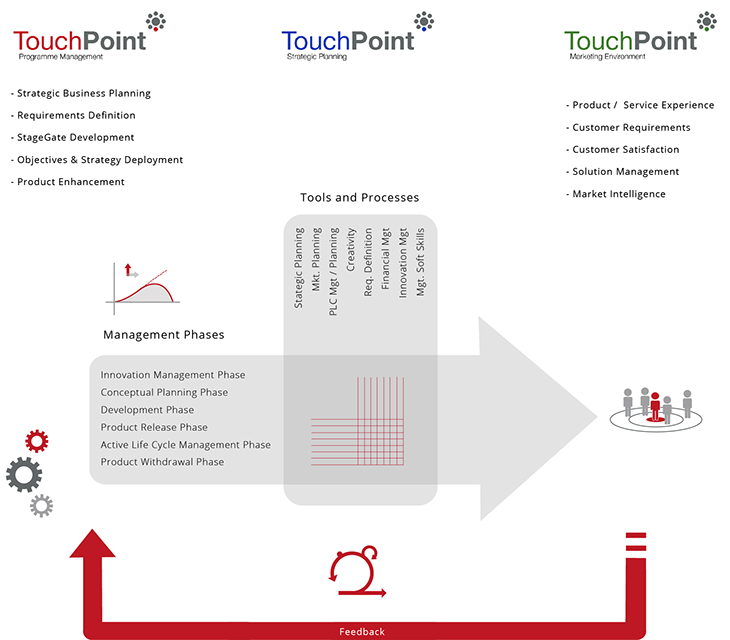Glossary
Logout
©Copyright Arcturus 2022, All Rights Reserved.
7
Terms & Conditions
|
|
|
|
Security & Privacy
Contact
PMM INTRODUCTION
Welcome
The Product Management Methodology™ (PMM) is an integrated Product Management process for strategically delivering market driven Products and Services.
The PMM (Product Management Methodology) architecture is based upon an innovative management framework developed entirely from first principles by IPM (Innovation Process Management) in 2008. The framework follows the principles of an 'open' architectural design, offering genuine scalability and flexibility providing a 'generic' solution across many business applications. In addition we've also provided unrivalled access to individual 'PMM design' elements within the framework so you have the ability to design your own process solution based upon proven 'Best Practice'.
Products and services are fundamental to the overall success of the company and as such require appropriate and timely management if key objectives are to be met. In order to realise the above, robust processes and procedures are required to manage every aspect of the product throughout individual lifecycles against (changing or otherwise) exact market requirements.
The importance of delivering the ‘right product’ at the ‘right time’ and in the ‘right place’ cannot be overstated and as such each product within the portfolio requires timely and appropriate action if the desired outcome is to be achieved. Product Management is the activity of managing the product portfolio from cradle to grave and is an important discipline in achieving the above objective.
The role and specific tasks of the ‘Product Manager’ (PM) however are many and interactively complex and often leads to nebulous definitions (terms of reference) as to what the product management role entails. This ultimately causes confusion to both the individual product manager and the rest of the organisation as to what the role of a PM is employed to achieve. Without a suitable process to follow, the PM is left to work out the role for themselves and this often leads to a heavy bias toward specific areas of personal interest. Needless to say managing in an ad-hoc manner will often lead to ‘time to market’ and or ‘strategic alignment’ problems which collectively adversely affect the chances of an otherwise successful product offering.
To summarise, best practice Product Management is a ‘critical success factor’ for delivering products and services in alignment with planned expectations. To realise the above goal, the Product Manager will require multidisciplinary support from the organisation and be driven by an appropriate end to end product management process so that absolutely nothing is missed. Overall the process should be appropriately supported by senior management.
The PMM™ methodology is a genuine process for Product Managers and has been developed from many years of experience delivering best in class products / services. It can be considered as a genuine framework for the professional PM practitioner. Developed from first principles the PMM will promulgate significant improvements in the product management discipline which in turn provides the following positive benefits;
- Traceable and auditable Product Management procedures
- A complete understanding of ‘what needs to be achieved’.
- Consistent and repeatable qualities directly associated with products
- Processes that can be accurately audited
- Identification and recognition of critical success factors and KPI’s
- Effective multi-disciplinary team management
- Improved requirements definition
- Leading to Competitive advantage
- Reduced time to market
As part of the design process, ‘interdependencies matrices’ confirmed the relative importance of individual tools and processes throughout. It is therefore with confidence that we can say that the process supports best practice in all aspects of Product Management.
The chosen architecture is both flexible and robust and ensures products are managed in a consistent and professional manner. Where applicable, processes are supported by software models and associated tools which will in turn reiterate a consistent approach throughout the Product Management community.
Each phase of the PMM has been mapped against 40+ ‘best practice' tools and processes (some of which have been appropriately enhanced to fulfill specific requirements) that guide and support the Product Manager through the lifecycle of the product / portfolio...
The work flow approach of the methodology is specifically designed to increase the throughput of products and ensures total alignment with the overall company strategy that ultimately leads to absolutely nothing being missed or overlooked. Careful attention to the process architecture has also ensured that the fundamental activity of managing products throughout their ‘lifecycle’ is not diluted in any way and ensures appropriate effort is channelled into required activities.
To realise ‘best in class’ as a management discipline, Product Management must be seen to be in complete control of their product portfolio(s) which in turn align with the company’s overall strategy at all times. Given the above objective, a Product Management process must be both robust and flexible to allow for all eventualities whilst managing the product through the defined phases.
Management Reporting:
The PMM™ offers significant benefits for Product Group Managers and Directors. Product plans created by the Product Manager provide consolidated reporting and include executive summaries and enables an interactive overview to be produced and provide comprehensive control.
PMM Methodology - Architecture:
The PM Methodology™ takes into account the entire end to end process from Ideation, Conceptual Planning, Product Development, Market Release, Active Lifecycle Management and finally into Product Withdrawal. Each of the stages mentioned above are mapped onto a time frame as follows;.
The below diagram also indicates a route for ‘product revision’ and or ‘product replacement’, this section being brought into the process during the ‘Active Lifecycle Management phase’ in the form of a ‘Product Continuum Cycle’. This in turn places appropriate emphasis on small incremental improvements (to maintain competitive advantage) across the product lifecycle which would be in alignment with strategic intention and market position.

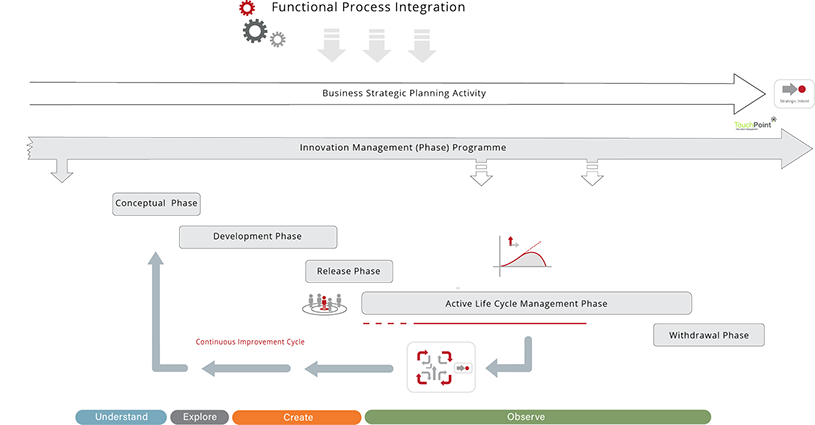
The above diagram also indicates a route for ‘product revision’ and or ‘product replacement’, this section being brought into the process during the ‘Active Lifecycle Management phase’ in the form of a ‘Product Continuum Cycle’. This in turn places appropriate emphasis on small incremental improvements (to maintain competitive advantage) across the product lifecycle which would be in alignment with strategic intention and market position
Product management is the activity of ‘product’ ownership from conception (ideation) to product withdrawal. It is an essential business discipline and the Product Manager is analogous to the conductor of an orchestra - without the conductor, uncontrolled pandemonium sets in with each instrument fighting to be heard in continuous cycle of disarray.
Product / Market Development Manager - Core Competencies and abilities Interactive Mindmap:
Product Management Roles and Responsibilities:
The role and responsibilities of the product manager is varied… not only are there variations across industries but also within the sectors themselves. To compound matters still further, business and industry have adopted their own idiosyncrasies, primarily due to fact there has been no generic standard adopted. This in turn has impacted upon the varied terms of reference of individual Product Managers leading to marked differences in remuneration.
The table matrix below shows the variations in responsibilities Vs defined management phases.
It is a common observation that Product Management is most successful when managed from cradle to grave in a consistent and pragmatic way. Splitting responsibilities leads to confusion and inconsistent strategies being adopted and in some instances promulgates a blame culture between Product Managers.
In conclusion, Product Manager ‘A’ with full responsibility across the 6 phases is the preferred choice. Any other variation / permutation is without doubt a compromise and quite possibly may ultimately result in lost business opportunities.
.
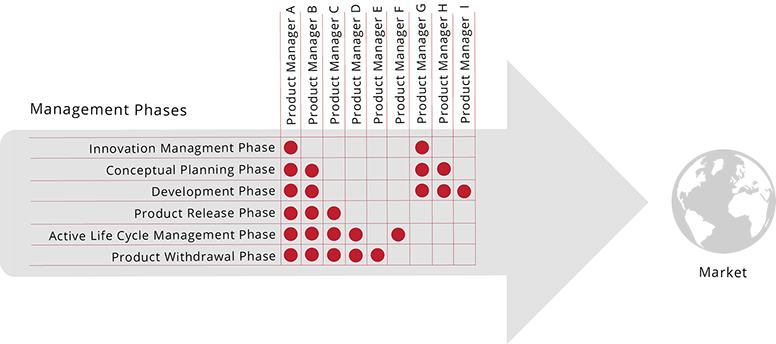
PMM Critical Success Factors:
Best practice ‘Product Management’ requires a thorough and pragmatic approach to this important discipline. The PMM process offers a proven generic framework for Product Managers to work within, however there are prerequisites that must be taken into account if PM’s are to deliver on expectations. The role (terms of reference) of the Product Manager can differ greatly between companies and associated market sectors, although there are generic similarities. One of the most common traits of successful PM’s is that they are seen and respected as the product champion with an appropriate level of authority to make things happen.
.
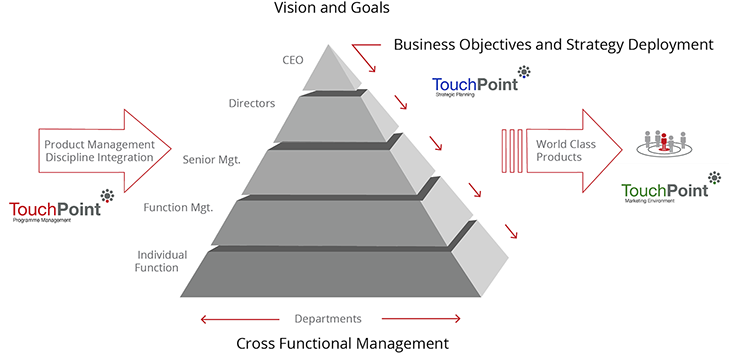
The PMM™ process should not be viewed in isolation and must be complemented with a multi-disciplinary approach (with representatives of all functional areas of the company) to the management of products. To be successful, the PM must lead in all areas. This will require truly competent Product Managers with a good balance of core competence skills operating as the chairperson of the management team.
For the individual Product Manager, managing across the functional areas of the company requires a certain presence and authority (perceived or otherwise) or by default a low level co-ordination role results. Sadly it is not uncommon to find Product Managers operating as technical sales representatives for their products. The above is compounded by the fact that PM’s typically do not have any direct reports across the functions so management soft skills become a prerequisite part of core competence.
Taking the above into account there are specific critical success factors that directly impact into the effectiveness of Product Management activities and therefore have a bearing on whether the product is a resounding success or failure.
Product Manager Core Competence:
From our own research the primary elements of product success will heavily depend upon the following being in place;
a) Product Management Core Competence
b) The Product Management Cultural Environment
The above can then be divided into related sub elements and appropriate measures set (which may be specific for your own markets) as follows:
Product Management Core Competence - defined and measured by the following sub elements;
1. Specific Product Knowledge & Understanding
2. Programme Mgt. (Multi-Disciplinary) the ability to manage multidisciplinary teams
3. Understanding and belief of Vision, Goals and Objectives
4. Strategic / Marketing / Financial Mgt Principles and Practice
5. PM Perceived Level of Authority
6. Product Management Soft Skills
Product Management Cultural Environment -defined and measured by the following sub elements;
1. PM Principles & Process Alignment
2. Customer / Market Driven Focus
3. Cross Functional Teams
4. Prod Mgt Remuneration…
5. Realistic and Balanced Workload
6. Director Sponsorship
A suitable plot can reveal whether the above criterion is being appropriately addressed.
.
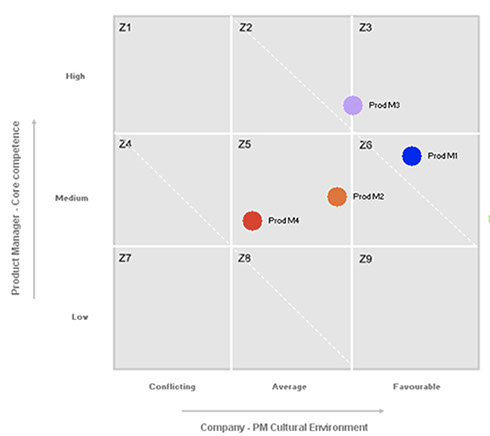
Product Management Activity Focus:
The architecture of the Product Management activity can be further broken down into 2 primary areas;
- Management Phases (product lifecycle related) and associated deliverable are broken down into 6 areas of which the Product Manager will immediately relate too.
Phases 1- 6;
1 Innovation Management
2 Conceptual Planning
3 Development
4 Product Release
5 Active Lifecycle
6 Product Withdrawal
- Product Management Tools and Processes which are broken down into 8 areas which cross map into each of the project phases detailed below.
Tools and Processes (Elements);
A Strategic Planning
B Marketing and Planning
C Creativity
D PLC Management and Planning
E Requirements Definition
F Financial Management
G Innovation Management
H Management Soft Skills
The resultant PMM™ process ensures that the Product Manager can quickly and directly relate to the proposed phase of their products. Corresponding sets of tools and processes are then linked to appropriately guide the Product Manager. This in turn is linked to a process with a series of stages and gates which will once again ensure consistent and unbiased product screening.
It should be noted that this process is not an alternative for suitably qualified and talented individuals who are in turn part of the Product Management Team.
Business Planning:
The core principles of the PMM™ relate to a continuous business planning process. At each phase (1 – 6) from Innovation Management through to Product Withdrawal a business plan (aligned to the requirements of that phase) is produced. Each section of the business plan is representative of a functional area of the company and as such the plan becomes a program management tool in itself with actions and owners being assigned to each functional area. By default this will enable the Product Manager to successfully and pro-actively manage the multi-disciplinary team without the need to have direct reports.
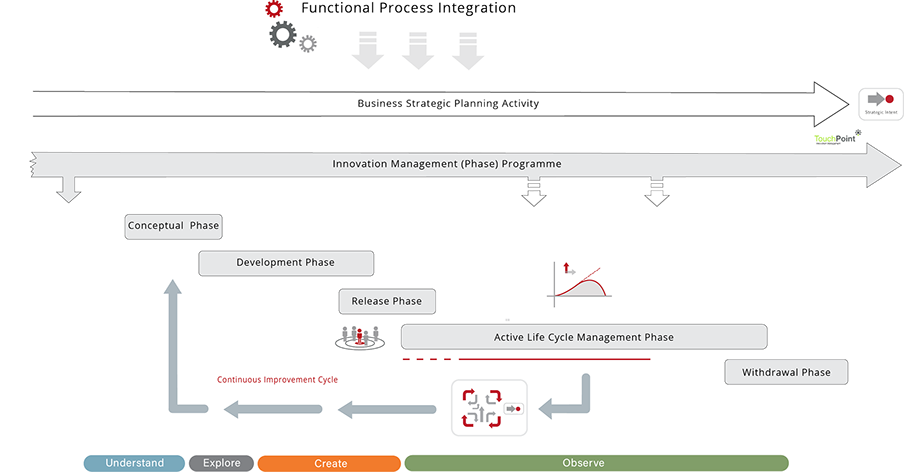
The above diagram indicates the key supporting activities and processes of the methodology
The process also supports a management by objective ethos with short, medium and long term planning horizons being acknowledged throughout.
Business objectives are managed / requested for each functional discipline involved in the overall PM process and are time related across each of the phases.
|PMM Phases 1-6
The principles of best practice Product Management lies in a robust planning structure. The principles of the PM methodology ensure that any product/project falls into one of the following time related phases. This enables a common set of process deliverables to be defined as follows:
